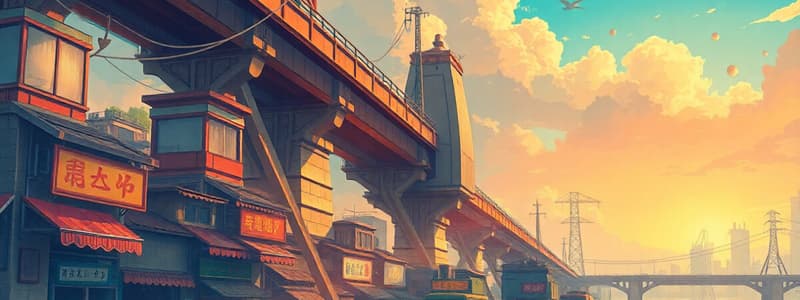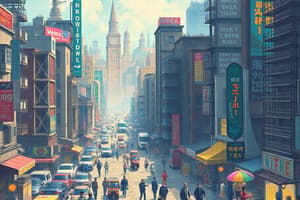Podcast
Questions and Answers
What was a primary motivation for internal migration during the period discussed?
What was a primary motivation for internal migration during the period discussed?
- Higher agricultural yields
- Educational advancements in rural areas
- Job opportunities in factories (correct)
- Desire for warmer climates
What infrastructure development was crucial to accommodate urban population growth?
What infrastructure development was crucial to accommodate urban population growth?
- Increased agricultural production
- Construction of rural roads
- Expansion of railroads and subways (correct)
- Improvement of local farms
Which of the following is a consequence of increased urbanization in cities?
Which of the following is a consequence of increased urbanization in cities?
- Decrease in economic opportunities
- Emergence of distinct social classes (correct)
- Increase in rural employment
- Reduction in population density
What role did labor movements play during this period?
What role did labor movements play during this period?
Which city was NOT mentioned as experiencing population growth due to urbanization?
Which city was NOT mentioned as experiencing population growth due to urbanization?
What impact did urbanization have on social issues?
What impact did urbanization have on social issues?
What characterized the cultural changes in urban areas during this time?
What characterized the cultural changes in urban areas during this time?
Which aspect of urban infrastructure was prioritized to improve living conditions?
Which aspect of urban infrastructure was prioritized to improve living conditions?
Flashcards are hidden until you start studying
Study Notes
Migration Patterns
- Internal Migration: Movement from rural areas to cities driven by job opportunities in factories.
- International Migration: Increased immigration from Europe (e.g., Ireland, Italy, Germany) to North America for better economic prospects.
- Urban Population Growth: Rapid urbanization led to significant population booms in cities; cities like New York, Chicago, and London expanded dramatically.
Urban Infrastructure
- Transportation Improvements: Development of railroads, streetcars, and subways to accommodate growing populations and facilitate commuting.
- Housing Development: Rapid construction of tenement buildings; often overcrowded and unsanitary conditions.
- Public Utilities: Expansion of water supply, sewage systems, and electrification improved city living, although disparities remained.
Socioeconomic Impacts
- Economic Growth: Cities became centers of commerce and industry, boosting national economies but increasing the wealth gap.
- Class Stratification: Distinct social classes emerged; a wealthy elite contrasted with a large working class and impoverished populations.
- Urban Poverty: Urbanization contributed to increased poverty and social issues, including crime and inadequate living conditions.
Labor Movements
- Workers' Rights: Emergence of labor unions and organizations advocating for better wages, hours, and working conditions.
- Strikes and Protests: Notable labor strikes (e.g., the Haymarket Affair, Pullman Strike) highlighted worker demands and increasing unrest.
- Legislation: Labor movements led to early labor laws, including minimum wage and child labor restrictions, stemming from public pressure.
Cultural Changes
- Diverse Communities: Cities became melting pots of cultures, fostering new social dynamics and conflicts.
- Art and Literature: Growth in artistic movements and literature focused on urban life, social issues, and working-class struggles (e.g., Naturalism).
- Education and Entertainment: Expansion of schools and cultural institutions (museums, theaters) as cities adapted to growing populations and their needs.
Migration Patterns
- People moved from rural areas to cities, particularly in the late 19th century
- This internal migration was driven by job opportunities in factories, especially in North America
- International migration also increased, notably from Europe (Ireland, Italy, Germany) seeking economic opportunities
- Cities like New York, Chicago, and London experienced significant population growth
Urban Infrastructure
- Cities adapted to rapid population growth through transportation improvements
- Railroads, streetcars, and subways were developed to facilitate commuting
- Housing development rapidly occurred, with often overcrowded and unsanitary tenement buildings being built
- Cities expanded public utilities such as water supply, sewage systems, and electrification, but disparities in access remained
Socioeconomic Impacts
- Urbanization led to economic growth as cities became centers of commerce and industry
- Cities boosted national economies but also widened wealth gaps
- Distinct social classes emerged, from a wealthy elite to a large working class and impoverished populations
- Urban poverty and social issues like crime and inadequate living conditions increased
Labor Movements
- Workers organized into labor unions and organizations to advocate for better wages, hours, and working conditions
- Labor strikes like the Haymarket Affair and Pullman Strike occurred, showcasing worker demands and increasing unrest
- Labor movements led to early labor laws limiting child labor and establishing minimum wage standards
Cultural Changes
- Cities became melting pots with diverse communities, leading to new social dynamics and conflicts
- This period saw the growth of artistic movements and literature focused on urban life, social issues, and working-class struggles, such as Naturalism
- Cities expanded schools and cultural institutions (museums, theaters) to cater to growing populations and their needs
Studying That Suits You
Use AI to generate personalized quizzes and flashcards to suit your learning preferences.




